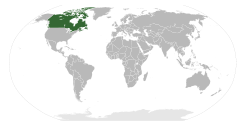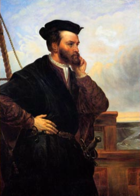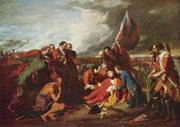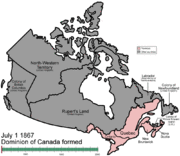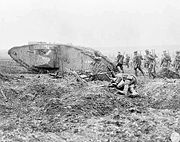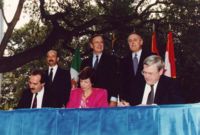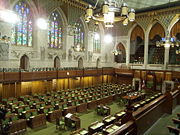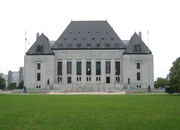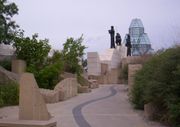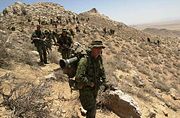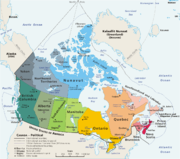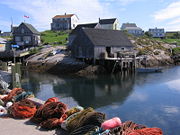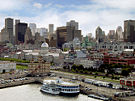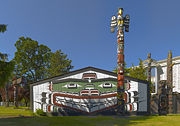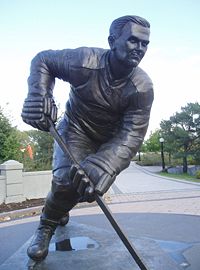Canada
2008/9 Schools Wikipedia Selection. Related subjects: Americas; North American Geography
| Canada | ||||||
|---|---|---|---|---|---|---|
|
||||||
| Motto: A Mari Usque Ad Mare (Latin) "From Sea to Sea" |
||||||
| Anthem: " O Canada" Royal anthem: " God Save the Queen" |
||||||
|
|
||||||
| Capital | Ottawa |
|||||
| Largest city | Toronto | |||||
| Official languages | English, French | |||||
| Recognised regional languages | Inuktitut, Inuinnaqtun, Cree, Dëne Sųłiné, Gwich’in, Inuvialuktun, Slavey, Tłįchǫ Yatiì | |||||
| Demonym | Canadian | |||||
| Government | Parliamentary democracy and Constitutional monarchy | |||||
| - | Monarch | HM Queen Elizabeth II | ||||
| - | Governor General | Michaëlle Jean | ||||
| - | Prime Minister | Stephen Harper | ||||
| Establishment | ||||||
| - | British North America Act | July 1, 1867 | ||||
| - | Statute of Westminster | December 11, 1931 | ||||
| - | Canada Act | April 17, 1982 | ||||
| Area | ||||||
| - | Total | 9,984,670 km² ( 2nd) 3,854,085 sq mi |
||||
| - | Water (%) | 8.92 (891,163 km²/344,080 mi²) | ||||
| Population | ||||||
| - | 2008 estimate | 33,343,000 ( 36th) | ||||
| - | 2006 census | 31,612,897 | ||||
| - | Density | 3.2/km² ( 219th) 8.3/sq mi |
||||
| GDP ( PPP) | 2007 estimate | |||||
| - | Total | $1.274 trillion ( 13th) | ||||
| - | Per capita | $38,200 ( 21st) | ||||
| GDP (nominal) | 2007 estimate | |||||
| - | Total | $1.432 trillion ( 9th) | ||||
| - | Per capita | $42,738 ( 14th) | ||||
| Gini | 32.1 (2005) | |||||
| HDI (2007) | ▲ 0.961 (high) ( 4th) | |||||
| Currency | Canadian dollar ($) ( CAD) |
|||||
| Time zone | ( UTC−3.5 to −8) | |||||
| - | Summer ( DST) | ( UTC−2.5 to −7) | ||||
| Internet TLD | .ca | |||||
| Calling code | +1 | |||||
| Canada portal | ||||||
Canada (IPA: /ˈkænədə/) is a country occupying most of northern North America, extending from the Atlantic Ocean in the east to the Pacific Ocean in the west and northward into the Arctic Ocean. It is the world's second largest country by total area, and shares land borders with the United States to the south and northwest.
The land occupied by Canada was inhabited for millennia by various aboriginal people. Beginning in the late 15th century, British and French expeditions explored and later settled the Atlantic coast. France ceded nearly all of its colonies in North America in 1763 after the Seven Years War. In 1867, with the union of three British North American colonies through Confederation, Canada was formed as a federal dominion of four provinces. This began an accretion of additional provinces and territories and a process of increasing autonomy from the United Kingdom, highlighted by the Statute of Westminster in 1931, and culminating in the Canada Act in 1982 which severed the vestiges of legal dependence on the British parliament.
A federation now comprising ten provinces and three territories, Canada is a parliamentary democracy and a constitutional monarchy, with Queen Elizabeth II as its head of state. It is a bilingual and multicultural country, with both English and French as official languages at the federal level. Technologically advanced and industrialized, Canada maintains a diversified economy that is heavily reliant upon its abundant natural resources and upon trade—particularly with the United States, with which Canada has had a long and complex relationship.
Etymology
The name Canada most likely comes from a St. Lawrence Iroquoian word kanata, meaning "village" or "settlement". In 1535, inhabitants of the present-day Quebec City region used the word to direct explorer Jacques Cartier toward the village of Stadacona. Cartier used the word 'Canada' to refer to not only that village, but the entire area subject to Donnacona, Chief at Stadacona. By 1545, European books and maps began referring to this region as Canada.
The French colony of Canada referred to the part of New France along the Saint Lawrence River and the northern shores of the Great Lakes. Later, it was split into two British colonies, called Upper Canada and Lower Canada until their union as the British Province of Canada in 1841. Upon Confederation in 1867, the name Canada was adopted for the entire country, and Dominion was conferred as the country's title. It was frequently referred to as the Dominion of Canada until the 1950s. As Canada asserted its political autonomy from Britain, the federal government increasingly used Canada on legal state documents and treaties. The Canada Act 1982 refers only to "Canada" and, as such, it is currently the only legal (and bilingual) name. This was reflected in 1982 with the renaming of the national holiday from Dominion Day to Canada Day.
History
Pre-colonial Canada
Various groups of Inuit (formerly known as Eskimos) and First Peoples inhabited North America prehistorically. While no written documents exist, various forms of rock art, petroforms, petroglyphs, and ancient artifacts provide thousands of years of information about the past. Archaeological studies support a human presence in northern Yukon from 26,500 years ago, and in southern Ontario from 9,500 years ago. Europeans first arrived when the Vikings settled briefly at L'Anse aux Meadows around AD 1000. The next Europeans to explore Canada's Atlantic coast included John Cabot in 1497 for England and Jacques Cartier in 1534 for France; seasonal Basque whalers and fishermen subsequently exploited the region between the Grand Banks and Tadoussac for over a century.
Colonial-era Canada
French explorer Samuel de Champlain arrived in 1603 and established the first permanent European settlements at Port Royal in 1605 and Quebec City in 1608. These would become respectively the capitals of Acadia and Canada. Among French colonists of New France, Canadiens extensively settled the St. Lawrence River valley, Acadians settled the present-day Maritimes, while French fur traders and Catholic missionaries explored the Great Lakes, Hudson Bay and the Mississippi watershed to Louisiana. The French and Iroquois Wars broke out over control of the fur trade.
The English established fishing outposts in Newfoundland around 1610 and colonized the Thirteen Colonies to the south. A series of four Intercolonial Wars erupted between 1689 and 1763. Mainland Nova Scotia came under British rule with the Treaty of Utrecht (1713); the Treaty of Paris (1763) ceded Canada and most of New France to Britain following the Seven Years' War.
The Royal Proclamation (1763) carved the Province of Quebec out of New France and annexed Cape Breton Island to Nova Scotia. It also restricted the language and religious rights of French Canadians. In 1769, St. John's Island (now Prince Edward Island) became a separate colony. To avert conflict in Quebec, the Quebec Act of 1774 expanded Quebec's territory to the Great Lakes and Ohio Valley and re-established the French language, Catholic faith, and French civil law in Quebec; it angered many residents of the Thirteen Colonies, helping to fuel the American Revolution. The Treaty of Paris (1783) recognized American independence and ceded territories south of the Great Lakes to the United States. Approximately 50,000 United Empire Loyalists fled the United States to Canada. New Brunswick was split from Nova Scotia as part of a reorganization of Loyalist settlements in the Maritimes. To accommodate English-speaking Loyalists in Quebec, the Constitutional Act of 1791 divided the province into French-speaking Lower Canada and English-speaking Upper Canada, granting each their own elected Legislative Assembly.
Canada (Upper and Lower) was the main front in the War of 1812 between the United States and British Empire. Its defence contributed to a sense of unity among British North Americans. Large-scale immigration to Canada began in 1815 from Britain and Ireland. The timber industry surpassed the fur trade in importance in the early nineteenth century.
The desire for Responsible Government resulted in the aborted Rebellions of 1837. The Durham Report subsequently recommended responsible government and the assimilation of French Canadians into British culture. The Act of Union (1840) merged The Canadas into a United Province of Canada. French and English Canadians worked together in the Assembly to reinstate French rights. Responsible government was established for all British North American provinces by 1849.
The signing of the Oregon Treaty by Britain and the United States in 1846 ended the Oregon boundary dispute, extending the border westward along the 49th parallel and paving the way for British colonies on Vancouver Island (1849) and in British Columbia (1858). Canada launched a series of western exploratory expeditions to claim Rupert's Land and the Arctic region. The Canadian population grew rapidly because of high birth rates; British immigration was offset by emigration to the United States, especially by French Canadians moving to New England.
Confederation to World War I
Following several constitutional conferences, the Constitution Act, 1867 brought about Confederation creating "one Dominion under the name of Canada" on July 1, 1867, with four provinces: Ontario, Quebec, Nova Scotia, and New Brunswick. Canada assumed control of Rupert's Land and the North-Western Territory to form the Northwest Territories, where Métis' grievances ignited the Red River Rebellion and the creation of the province of Manitoba in July 1870. British Columbia and Vancouver Island (which had united in 1866) and the colony of Prince Edward Island joined Confederation in 1871 and 1873, respectively.
Prime Minister John A. Macdonald's Conservative Party established a National Policy of tariffs to protect nascent Canadian manufacturing industries. To open the West, the government sponsored construction of three trans-continental railways (most notably the Canadian Pacific Railway), opened the prairies to settlement with the Dominion Lands Act, and established the North-West Mounted Police to assert its authority over this territory. In 1898, after the Klondike Gold Rush in the Northwest Territories, the Canadian government created the Yukon territory. Under Liberal Prime Minister Wilfrid Laurier, continental European immigrants settled the prairies, and Alberta and Saskatchewan became provinces in 1905.
Canada automatically entered the First World War in 1914 with Britain's declaration of war, sending volunteers to the Western Front, who played a substantial role in the Battle of Vimy Ridge. The Conscription Crisis of 1917 erupted when conservative Prime Minister Robert Borden brought in compulsory military service over the objection of French-speaking Quebecers. In 1919, Canada joined the League of Nations independently of Britain; in 1931 the Statute of Westminster affirmed Canada's independence.
1920s to 1960s: Great Depression, World War II, and post-war period
The Great Depression of 1929 brought economic hardship to all of Canada. In response, the Co-operative Commonwealth Federation (CCF) in Alberta and Saskatchewan presaged a welfare state as pioneered by Tommy Douglas in the 1940s and 1950s. Canada declared war on Germany independently during World War II under Liberal Prime Minister William Lyon Mackenzie King, three days after Britain. The first Canadian Army units arrived in Britain in December 1939. Canadian troops played important roles in the Battle of the Atlantic, the failed 1942 Dieppe Raid in France, the Allied invasion of Italy, the D-Day landings, the Battle of Normandy and the Battle of the Scheldt in 1944. Canada is credited by the Netherlands for having provided asylum and protection for its monarchy during the war after the country was occupied and the Netherlands credits Canada for its leadership and major contribution to the liberation of Netherlands from Nazi Germany. The Canadian economy boomed as industry manufactured military materiel for Canada, Britain, China and the Soviet Union. Despite another Conscription Crisis in Quebec, Canada finished the war with one of the largest armed forces in the world. In 1945, during the war, Canada became one of the first countries to join the United Nations
In 1949, Newfoundland joined Confederation. Post-war prosperity and economic expansion ignited a baby boom and attracted immigration from war-ravaged European countries.
1960s to 1980s: New Canadian identity, official bilingualism, and patriation of the Constitution
Under successive Liberal governments of Lester B. Pearson and Pierre Trudeau, a new Canadian identity emerged. Canada adopted its current Maple Leaf Flag in 1965. In response to a more assertive French-speaking Quebec, the federal government became officially bilingual with the Official Languages Act of 1969. Non-discriminatory Immigration Acts were introduced in 1967 and 1976, and official multiculturalism in 1971; waves of non-European immigration had changed the face of the country. Social welfare programs such as universal health care, the Canada Pension Plan, and Canada Student Loans were initiated in the 1960s and consolidated in the 1970s; provincial governments, particularly Quebec, fought these as incursions into their jurisdictions. Finally, Prime Minister Trudeau pushed through the patriation of the constitution from Britain, enshrining a Charter of Rights and Freedoms based on individual rights in the Constitution Act of 1982. Canadians continue to take pride in their system of universal health care, their commitment to multiculturalism, and human rights.
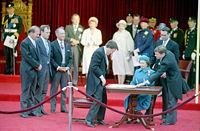
Quebec underwent profound social and economic changes during the Quiet Revolution of the 1960s. Quebec nationalists under Jean Lesage began pressing for greater autonomy . The radical Front de libération du Québec (FLQ) ignited the October Crisis in 1970 with bombings and kidnappings. The more moderate Parti Québécois of René Lévesque came to power in 1976 and held an unsuccessful referendum on a proposed " sovereignty-association" (political sovereignty and separation of Quebec from Canada while maintaining a common economy with Canada) in the 1980 Quebec referendum. An energy crisis and economic decline in the late 1970s caused the federal government of Prime Minister Pierre Elliot Trudeau to adopt price controls and redistribution of oil profits from Alberta's booming oil industry to Canada's poorer provinces as part of the National Energy Program (NEP). The NEP was fiercely opposed by Albertans and other western Canadians saw the plan as eastern Canada exploiting Alberta's oil boom which caused an increase in a sense of political and social alienation of western Canada by its residents.
1980s to present: Continental integration, regional tensions, and changing Aboriginal affairs
The Progressive Conservative government of Brian Mulroney began efforts to recognize Quebec as a "distinct society" and end western alienation. The National Energy Program was scrapped and in 1987 talks began with Quebec to officially have Quebec sign the Canadian Constitution these collapsed in 1990. Under Mulroney, relations with the United States improved and both Canada and the U.S. began to grow more closely integrated. In 1986, Canada and the U.S. signed the Acid Rain Treaty to reduce acid rain. In 1989, the federal government adopted the Free Trade Agreement with the United States despite significant animosity from the Canadian public who were concerned about the economic and cultural impacts of close integration with the United States.
In the 1990s, anger in predominantly French-speaking Quebec with the failure of constitutional reform talks, and the rising sense of alienation in Canada's western provinces due to the government's preoccupation with attempting to convince Quebec's government to officially endorse the Constitution. After Mulroney resigned as Prime Minister in 1993, Kim Campbell took over and became Canada's first woman Prime Minister. Campbell only remained in office for a few months and the 1993 election saw the collapse of the Progressive Conservative Party from government to only 2 seats, while two new regional political parties: the Quebec-based sovereigntist Bloc Québécois became the official opposition and the largely Western Canada-supported Reform Party of Canada took most of Canada's western ridings. In 1995, the government of Quebec held a second referendum on sovereignty in 1995 that was rejected by a slimmer margin of just 50.6% to 49.4%. In 1997, the Canadian Supreme Court ruled unilateral secession by a province to be unconstitutional, and Parliament passed the " Clarity Act" outlining the terms of a negotiated departure.
The 1990s was a period of economic turmoil in Canada as Canada suffered from high unemployment in the early 1990s and a large debt and deficit that had been accumulating for years. Both Progressive Conservative and Liberal governments in the federal government and Progressive Conservative governments in Alberta and Ontario made major cutbacks in social welfare spending and significant privatization of government-provided services, government-owned corporations ( crown corporations), and utilities occurred during this period as a means to end government deficit and reduce government debt.
A number of hostile and controversial confrontations occurred between Canadian aboriginal groups and non-aboriginals over the issue of violations of aboriginal treaty rights entered the public spotlight in the 1990s. The Oka crisis in 1990, in which the Canadian armed forces was sent in to stop a protest by aboriginals who refused to allow the building of a golf club on land claimed by aboriginals. In 1995, a controversial standoff in Ipperwash, Ontario resulted in an aboriginal protester being shot dead and a subsequent inquiry discovered prevalent racism amongst the police officers involved in the standoff. Despite this a number of high-profile changes occurred to improve aboriginal rights, such as the signing of the Nisga'a Final Agreement, a treaty between the Nisga'a people, the provincial government of British Columbia and the federal government signed in 1999 which resolved land claims issues. In the 1980s, the federal government responded to demands by the Arctic Inuit people for self-governance and in 1999 granted the creation of the territory of Nunavut, which allowed the Inuktitut language to be an official language of the new territory.
In the 2000s, significant social and political changes have occurred in Canada. Canada's border control policy and foreign policy were altered as a result of the political impact of the September 11, 2001 attacks on the United States in 2001 resulting in increased pressure from the U.S. and adoption by Canada of initiatives to secure Canada's side of the border to the U.S. and Canada supported U.S.-led military action against the radical Islamic militant organization Al Qaeda in Afghanistan which was determined to have been responsible for the attacks on the United States. Canada did not support the U.S.-led war in Iraq in 2003 which led to increased political animosity between the Canadian and U.S. governments at the time. Environmental issues increased in importance in Canada resulting in the signing of the Kyoto Accord on climate change by Canada's Liberal government in 2002 but recently nullified by the present government which has proposed a "made-in-Canada" solution to climate change. A merger of the Canadian Alliance and PC Party into the Conservative Party of Canada was completed in 2003, ending a ten year division of the conservative vote, and was elected as a minority government under the leadership of Stephen Harper in the 2006 federal election, ending thirteen years of Liberal party dominance in elections. In 2006, Canada's government declared that Quebec's predominantly French-speaking people, the Quebecois, constitute a nation within Canada. In 2008, Canada's government officially apologized for its endorsement of residential schools for Canada's aboriginal peoples which had promoted forced cultural assimilation oppression of aboriginal culture, and physical and emotional abuse of aboriginal people. Canada's aboriginal leaders accepted the government's apology.
Government and politics

Canada is a constitutional monarchy with Elizabeth II, Queen of Canada, as head of state and the Prime Minister as the head of the government. The country is a parliamentary democracy with a federal system of parliamentary government and strong democratic traditions.
Executive authority is formally and constitutionally vested in the monarch. However, by convention, the monarch and her appointed representative, the Governor General, act in a predominantly ceremonial and apolitical role, deferring the exercise of executive power to the Cabinet, which is made up of ministers generally accountable to the elected House of Commons, and headed by the Prime Minister, who is normally the leader of the party that holds the confidence of the House of Commons. Thus, the Cabinet is typically regarded as the active seat of executive power. This arrangement, which stems from the principals of responsible government, ensures the stability of government, and makes the Prime Minister's Office one of the most powerful organs of the system, tasked with selecting, besides the other Cabinet members, Senators, federal court judges, heads of Crown corporations and government agencies, and the federal and provincial viceroys for appointment. However, the sovereign and Governor General do retain their right to use the Royal Prerogative in exceptional constitutional crisis situations.
The leader of the party with the second most seats usually becomes the Leader of the Opposition and is part of an adversarial parliamentary system that keeps the government in check. Michaëlle Jean has served as Governor General since September 27, 2005; Stephen Harper, leader of the Conservative Party, has been Prime Minister since February 6, 2006; and Stéphane Dion, leader of the Liberal Party of Canada, has been Leader of the Opposition since December 2, 2006.
The federal parliament is made up of the Queen (represented by the Governor General) and two houses: an elected House of Commons and an appointed Senate. Each member in the House of Commons is elected by simple plurality in a riding or electoral district. General elections are either every four years as determined by fixed election date legislation, or triggered by the government losing the confidence of the House (usually only possible during minority governments). Members of the Senate, whose seats are apportioned on a regional basis, are chosen by the Prime Minister and formally appointed by the Governor General, and serve until age 75.
Four parties have had substantial representation in the federal parliament since 2006 elections: the Conservative Party of Canada (governing party), the Liberal Party of Canada (Official Opposition), the New Democratic Party (NDP), and the Bloc Québécois. The Green Party of Canada does not have current representation in Parliament but garners a significant share of the national vote. The list of historical parties with elected representation is substantial.
In line with Canada's federalist structure, the constitution divides government responsibilities between the federal government and the ten provinces, whose unicameral provincial legislatures operate in parliamentary fashion similar to the federal House of Commons. Canada's three territories also have legislatures, but with less constitutional responsibilities than the provinces, and with some structural differences (for example, the Legislative Assembly of Nunavut has no parties and operates on consensus).
Law
The constitution is the supreme law of the country, and consists of written text and unwritten conventions. The Constitution Act, 1867, affirmed governance based on parliamentary precedent "similar in principle to that of the United Kingdom" and divided powers between the federal and provincial governments; the Statute of Westminster, 1931, granted full autonomy; and the Constitution Act, 1982, added the Canadian Charter of Rights and Freedoms, which guarantees basic rights and freedoms that usually cannot be overridden by any level of government – though a notwithstanding clause allows the federal parliament and provincial legislatures to override certain sections of the Charter for a period of five years – and added a constitutional amending formula.
Canada's judiciary plays an important role in interpreting laws and has the power to strike down laws that violate the Constitution. The Supreme Court of Canada is the highest court and final arbiter and is led by the Right Honourable Madam Chief Justice Beverley McLachlin, P.C. since 2000. Its nine members are appointed by the Governor General on the advice of the Prime Minister and Minister of Justice. All judges at the superior and appellate levels are appointed after consultation with non-governmental legal bodies. The federal cabinet also appoints justices to superior courts at the provincial and territorial levels. Judicial posts at the lower provincial and territorial levels are filled by their respective governments.
Common law prevails everywhere except in Quebec, where civil law predominates. Criminal law is solely a federal responsibility and is uniform throughout Canada. Law enforcement, including criminal courts, is a provincial responsibility, but in rural areas of all provinces except Ontario and Quebec, policing is contracted to the federal Royal Canadian Mounted Police.
Foreign relations and military
Canada and the United States share the world's longest undefended border, co-operate on military campaigns and exercises, and are each other's largest trading partners. Canada has nevertheless maintained an independent foreign policy, most notably maintaining full relations with Cuba and declining to participate in the Iraq War. Canada also maintains historic ties to the United Kingdom and France and to other former British and French colonies through Canada's membership in the Commonwealth of Nations and La Francophonie (French-Speaking Countries). Canada is noted for having a strong and positive relationship with the Netherlands which Canada helped liberate during World War II, and the Dutch government traditionally gives tulips, a symbol of the Netherlands, to Canada each year in remembrance of Canada's contribution to its liberation.
Canada currently employs a professional, volunteer military force of about 64,000 regular and 26,000 reserve personnel. The unified Canadian Forces (CF) comprise the army, navy, and air force. Major CF equipment deployed includes 1,400 armoured fighting vehicles, 34 combat vessels, and 861 aircraft.
Strong attachment to the British Empire and Commonwealth in English Canada led to major participation in British military efforts in the Second Boer War, the First World War, and the Second World War. Since then, Canada has been an advocate for multilateralism, making efforts to resolve global issues in collaboration with other nations. Canada joined the United Nations in 1945 and became a founding member of NATO in 1949. During the Cold War, Canada was a major contributor to UN forces in the Korean War and founded the North American Aerospace Defense Command (NORAD) in cooperation with the United States to defend against aerial attacks from the Soviet Union.
Canada has played a leading role in UN peacekeeping efforts. During the Suez Crisis of 1956, Lester B. Pearson eased tensions by proposing the inception of the United Nations Peacekeeping Force. Canada has since served in 50 peacekeeping missions, including every UN peacekeeping effort until 1989 and has since maintained forces in international missions in Rwanda, the former Yugoslavia, and elsewhere.
Canada joined the Organization of American States (OAS) in 1990; Canada hosted the OAS General Assembly in Windsor, Ontario, in June 2000 and the third Summit of the Americas in Quebec City in April 2001. Canada seeks to expand its ties to Pacific Rim economies through membership in the Asia-Pacific Economic Cooperation forum (APEC).
Since 2001, Canada has had troops deployed in Afghanistan as part of the U.S. stabilization force and the UN-authorized, NATO-commanded International Security Assistance Force. Canada's Disaster Assistance Response Team (DART) has participated in three major relief efforts in the past two years; the two-hundred member team has been deployed in relief operations after the December 2004 tsunami in South Asia, Hurricane Katrina in September 2005 and the Kashmir earthquake in October 2005.
In February 2007, Canada, Italy, Britain, Norway, and Russia announced their funding commitments to launch a $1.5 billion project to help develop vaccines they said could save millions of lives in poor nations, and called on others to join them. In August 2007, Canadian sovereignty in Arctic waters was challenged following a Russian expedition that planted a Russian flag at the seabed at the North Pole. Canada has considered that area to be sovereign territory since 1925.
Provinces and territories
Canada is a federation composed of ten provinces and three territories; in turn, these may be grouped into regions. Western Canada consists of British Columbia and the three Prairie provinces ( Alberta, Saskatchewan, and Manitoba). Central Canada consists of Quebec and Ontario. Atlantic Canada consists of the three Maritime provinces ( New Brunswick, Prince Edward Island, and Nova Scotia), along with Newfoundland and Labrador. Eastern Canada refers to Central Canada and Atlantic Canada together. Three territories ( Yukon, Northwest Territories, and Nunavut) make up Northern Canada. Provinces have more autonomy than territories. Each has its own provincial or territorial symbols.
The provinces are responsible for most of Canada's social programs (such as health care, education, and welfare) and together collect more revenue than the federal government, an almost unique structure among federations in the world. Using its spending powers, the federal government can initiate national policies in provincial areas, such as the Canada Health Act; the provinces can opt out of these but rarely do so in practice. Equalization payments are made by the federal government to ensure that reasonably uniform standards of services and taxation are kept between the richer and poorer provinces.
All provinces have unicameral, elected legislatures headed by a Premier selected in the same way as the Prime Minister of Canada. Each province also has a Lieutenant-Governor representing the Queen, analogous to the Governor General of Canada. The Lieutenant-Governor is appointed on the recommendation of the Prime Minister of Canada, though with increasing levels of consultation with provincial governments in recent years.
Geography and climate
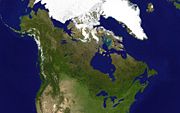
Canada occupies a major northern portion of North America, sharing land borders with the contiguous United States to the south and with the U.S. state of Alaska to the northwest, stretching from the Atlantic Ocean in the east to the Pacific Ocean in the west; to the north lies the Arctic Ocean. By total area (including its waters), Canada is the second largest country in the world—after Russia—and largest on the continent. By land area it ranks fourth. Since 1925, Canada has claimed the portion of the Arctic between 60°W and 141°W longitude, but this claim is not universally recognized. The northernmost settlement in Canada and in the world is Canadian Forces Station (CFS) Alert on the northern tip of Ellesmere Island—latitude 82.5°N—just 817 kilometres (450 nautical miles) from the North Pole. Canada has the longest coastline in the world: 243,000 kilometres.
The population density, 3.5 inhabitants per square kilometre (9.1 /sq mi), is among the lowest in the world. The most densely populated part of the country is the Quebec City-Windsor Corridor along the Great Lakes and Saint Lawrence River in the southeast. To the north of this region is the broad Canadian Shield, an area of rock scoured clean by the last ice age, thinly soiled, rich in minerals, and dotted with lakes and rivers. Canada by far has more lakes than any other country and has a large amount of the world's freshwater.
In eastern Canada, most people live in large urban centres on the flat Saint Lawrence Lowlands. The Saint Lawrence River widens into the world's largest estuary before flowing into the Gulf of Saint Lawrence. The gulf is bounded by Newfoundland to the north and the Maritime provinces to the south. The Maritimes protrude eastward along the Appalachian Mountain range from northern New England and the Gaspé Peninsula of Quebec. New Brunswick and Nova Scotia are divided by the Bay of Fundy, which experiences the world's largest tidal variations. Ontario and Hudson Bay dominate central Canada. West of Ontario, the broad, flat Canadian Prairies spread toward the Rocky Mountains, which separate them from British Columbia.
In northwestern Canada, the Mackenzie River flows from the Great Slave Lake to the Arctic Ocean. A tributary of a tributary of the Mackenzie is the South Nahanni River, which is home to Virginia Falls, a waterfall about twice as high as Niagara Falls.
Northern Canadian vegetation tapers from coniferous forests to tundra and finally to Arctic barrens in the far north. The northern Canadian mainland is ringed with a vast archipelago containing some of the world's largest islands.
Average winter and summer high temperatures across Canada vary depending on the location. Winters can be harsh in many regions of the country, particularly in the interior and Prairie provinces which experience a continental climate, where daily average temperatures are near −15 ° C (5 ° F) but can drop below −40 °C (−40 °F) with severe wind chills. In non-coastal regions, snow can cover the ground almost six months of the year (more in the north). Coastal British Columbia is an exception and enjoys a temperate climate with a mild and rainy winter.
On the east and west coast, average high temperatures are generally in the low 20s °C (70s °F), while between the coasts the average summer high temperature ranges from 25 to 30 °C (75 to 85 °F) with occasional extreme heat in some interior locations exceeding 40 °C (104 °F). For a more complete description of climate across Canada see Environment Canada's Website.
Economy
Canada is one of the world's wealthiest nations, with a high per-capita income, and is a member of the Organisation for Economic Co-operation and Development (OECD) and Group of Eight. It is one of the world's top 10 trading nations. Canada is a mixed market, ranking lower than the U.S. but higher than most western European nations on the Heritage Foundation's index of economic freedom. Since the early 1990s, the Canadian economy has been growing rapidly with low unemployment and large government surpluses on the federal level. Today Canada closely resembles the U.S. in its market-oriented economic system, pattern of production, and high living standards. As of October 2007, Canada's national unemployment rate of 5.9% is its lowest in 33 years. Provincial unemployment rates vary from a low of 3.6% in Alberta to a high of 14.6% in Newfoundland and Labrador. 2008 forbes global 2000 list of world's largest companies, Canada had 69 companies in the list ranking 5th next to France.. As of 2007, the Canada’s total government debt was $467.3 billion CAD, or 68.5% of GDP.
In the past century, the growth of the manufacturing, mining, and service sectors has transformed the nation from a largely rural economy into one primarily industrial and urban. As with other first world nations, the Canadian economy is dominated by the service industry, which employs about three quarters of Canadians. However, Canada is unusual among developed countries in the importance of the primary sector, with the logging and oil industries being two of Canada's most important.
Canada is one of the few developed nations that are net exporters of energy. Atlantic Canada has vast offshore deposits of natural gas and large oil and gas resources are centred in Alberta. The vast Athabasca Tar Sands give Canada the world's second largest oil reserves behind Saudi Arabia. In Quebec, British Columbia, Newfoundland & Labrador, New Brunswick, Ontario and Manitoba, hydroelectric power is a cheap and clean source of renewable energy.
Canada is one of the world's most important suppliers of agricultural products, with the Canadian Prairies one of the most important suppliers of wheat, canola and other grains. Canada is the world's largest producer of zinc and uranium and a world leader in many other natural resources such as gold, nickel, aluminium, and lead; many towns in the northern part of the country, where agriculture is difficult, exist because of a nearby mine or source of timber. Canada also has a sizeable manufacturing sector centred in southern Ontario and Quebec, with automobiles and aeronautics representing particularly important industries.
Economic integration with the United States has increased significantly since World War II. The Canada-United States Automotive Agreement in 1965 opened the borders to trade in the auto manufacturing industry. The Canada-United States Free Trade Agreement of 1988 eliminated tariffs between the two countries, while North American Free Trade Agreement expanded the free trade zone to include Mexico in the 1990s . Canadian nationalists continue to worry about their cultural autonomy as American television shows, movies and corporations are omnipresent.
Since 2001, Canada has successfully avoided economic recession and has maintained the best overall economic performance in the G8. Since the mid-1990s, Canada's federal government has posted annual budgetary surpluses and has steadily paid down the national debt.
Demographics
| Largest Metropolitan Areas of Canada | |||||||||||
|---|---|---|---|---|---|---|---|---|---|---|---|
| Rank | Core City | Province | Pop. | Rank | Core City | Province | Pop. | ||||
| 1 | Toronto | Ontario | 5,113,149 | 11 | Kitchener | Ontario | 451,235 | ||||
| 2 | Montreal | Quebec | 3,635,571 | 12 | St. Catharines | Ontario | 390,317 | ||||
| 3 | Vancouver | British Columbia | 2,116,581 | 13 | Halifax | Nova Scotia | 372,858 | ||||
| 4 | Ottawa | Ontario | 1,130,761 | 14 | Oshawa | Ontario | 330,594 | ||||
| 5 | Calgary | Alberta | 1,079,310 | 15 | Victoria | British Columbia | 330,088 | ||||
| 6 | Edmonton | Alberta | 1,034,945 | 16 | Windsor | Ontario | 323,342 | ||||
| 7 | Quebec City | Quebec | 715,515 | 17 | Saskatoon | Saskatchewan | 233,923 | ||||
| 8 | Winnipeg | Manitoba | 694,668 | 18 | Regina | Saskatchewan | 194,971 | ||||
| 9 | Hamilton | Ontario | 692,911 | 19 | Sherbrooke | Quebec | 186,952 | ||||
| 10 | London | Ontario | 457,720 | 20 | St. John's | Newfoundland and Labrador | 181,113 | ||||
| Canada 2006 Census | |||||||||||
| Largest Cities of Canada | |||||||||||
|---|---|---|---|---|---|---|---|---|---|---|---|
| Rank | City | Province | Pop. | Rank | City | Province | Pop. | ||||
| 1 | Toronto | Ontario | 2,503,281 | 11 | Brampton | Ontario | 433,806 | ||||
| 2 | Montreal | Quebec | 1,620,693 | 12 | Surrey | British Columbia | 394,976 | ||||
| 3 | Calgary | Alberta | 1,019,942 | 13 | Halifax | Nova Scotia | 372,679 | ||||
| 4 | Ottawa | Ontario | 812,129 | 14 | Laval | Quebec | 368,709 | ||||
| 5 | Edmonton | Alberta | 730,372 | 15 | London | Ontario | 352,395 | ||||
| 6 | Mississauga | Ontario | 668,549 | 16 | Markham | Ontario | 261,573 | ||||
| 7 | Winnipeg | Manitoba | 633,451 | 17 | Gatineau | Quebec | 242,124 | ||||
| 8 | Vancouver | British Columbia | 578,041 | 18 | Vaughan | Ontario | 238,866 | ||||
| 9 | Hamilton | Ontario | 504,559 | 19 | Longueuil | Quebec | 229,330 | ||||
| 10 | Quebec City | Quebec | 491,142 | 20 | Windsor | Ontario | 216,473 | ||||
| Canada 2006 Census | |||||||||||
Canada's 2006 census counted a total population of 31,612,897, an increase of 5.4% since 2001. Population growth is from immigration and, to a lesser extent, natural growth. About three-quarters of Canada's population live within 150 kilometres (90 mi) of the US border. A similar proportion live in urban areas concentrated in the Quebec City-Windsor Corridor (notably the Greater Golden Horseshoe including Toronto and area, Montreal, and Ottawa), the BC Lower Mainland (consisting of the region surrounding Vancouver), and the Calgary-Edmonton Corridor in Alberta.
According to the 2006 census, there are 43 ethnic origins that at least one hundred thousand people in Canada claim in their background. The largest ethnic group is English (21%), followed by French (15.8%), Scottish (15.2%), Irish (13.9%), German (10.2%), Italian (5%), Chinese (4%), Ukrainian (3.6%), and First Nations (3.5%); Approximately, one third of respondents identified their ethnicity as "Canadian. Canada's aboriginal population is growing almost twice as fast as the Canadian average. In 2006, 16.2% of the population belonged to non-aboriginal visible minorities.
In 2001, 49% of the Vancouver population and 42.8% of Toronto's population were visible minorities. In March 2005, Statistics Canada projected that people of non-European origins will constitute a majority in both Toronto and Vancouver by 2012. According to Statistics Canada's forecasts, the number of visible minorities in Canada is expected to double by 2017. A survey released in 2007 reveals that virtually 1 in 5 Canadians (19.8%) are foreign born. Nearly 60% of new immigrants hail from Asia (including the Middle East).
Canada has the highest per capita immigration rate in the world, driven by economic policy and family reunification; Canada also accepts large numbers of refugees. Newcomers settle mostly in the major urban areas of Toronto, Vancouver and Montreal. In the 2006 census, there were 5,068,100 people considered to belong to a visible minority, making up 16.2% of the population. Between 2001 and 2006, the visible minority population rose by 27.2 %.
Support for religious pluralism is an important part of Canada's political culture. According to the 2001 census, 77.1% of Canadians identify as being Christians; of this, Catholics make up the largest group (43.6% of Canadians). The largest Protestant denomination is the United Church of Canada. About 16.5% of Canadians declare no religious affiliation, and the remaining 6.3% are affiliated with religions other than Christianity, of which the largest is Islam numbering 1.9%, followed by Judaism at 1.1%.
Canadian provinces and territories are responsible for education. Each system is similar, while reflecting regional history, culture and geography. The mandatory school age ranges between 5–7 to 16–18 years, contributing to an adult literacy rate that is 99%. Postsecondary education is also administered by provincial and territorial governments, who provide most of the funding; the federal government administers additional research grants, student loans and scholarships. In 2002, 43% of Canadians aged between 25 and 64 had post-secondary education; for those aged 25 to 34 the post-secondary education rate reaches 51%.
Culture
Canadian culture has historically been influenced by British, French, and Aboriginal cultures and traditions. It has also been influenced by American culture because of its proximity and migration between the two countries. American media and entertainment are popular, if not dominant, in English Canada; conversely, many Canadian cultural products and entertainers are successful in the U.S. and worldwide. Many cultural products are marketed toward a unified "North American" or global market.
The creation and preservation of distinctly Canadian culture are supported by federal government programs, laws and institutions such as the Canadian Broadcasting Corporation (CBC), the National Film Board of Canada (NFB), and the Canadian Radio-television and Telecommunications Commission (CRTC).
Canada is a geographically vast and ethnically diverse country. Canadian culture has also been greatly influenced by immigration from all over the world. Many Canadians value multiculturalism and see Canadian culture as being inherently multicultural. Multicultural heritage is the basis of Section 27 of the Canadian Charter of Rights and Freedoms.
National symbols are influenced by natural, historical, and First Nations sources. Particularly, the use of the maple leaf as a Canadian symbol dates back to the early 18th century and is depicted on its current and previous flags, the penny, and on the coat of arms. Other prominent symbols include the beaver, Canada goose, common loon, the Crown, the RCMP, and more recently the totem pole and inukchuk.
Canada's official national sports are ice hockey in the winter and lacrosse in the summer. Ice hockey is a national pastime and the most popular spectator sport in the country. It is the most popular sport Canadians play, with 1.65 million active participants in 2004. Canada's six largest metropolitan areas – Toronto, Montreal, Vancouver, Ottawa, Calgary, and Edmonton – have franchises in the National Hockey League (NHL), and there are more Canadian players in the league than from all other countries combined. After hockey, other popular spectator sports include curling and football; the latter is played professionally in the Canadian Football League (CFL). Golf, baseball, skiing, soccer, volleyball, and basketball are widely played at youth and amateur levels, but professional leagues and franchises are not as widespread.
Canada hosted several high-profile international sporting events, including the 1976 Summer Olympics, the 1988 Winter Olympics, and the 2007 FIFA U-20 World Cup. Canada will be the host country for the 2010 Winter Olympics in Vancouver and Whistler, British Columbia.
Language
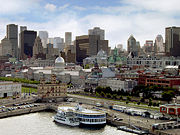
Canada's two official languages are English and French. Official Bilingualism in Canada is law, defined in the Canadian Charter of Rights and Freedoms, the Official Languages Act, and Official Language Regulations; it is applied by the Commissioner of Official Languages. English and French have equal status in federal courts, Parliament, and in all federal institutions. The public has the right, where there is sufficient demand, to receive federal government services in either English or French, and official language minorities are guaranteed their own schools in all provinces and territories.
English and French are the mother tongues of 59.7% and 23.2% of the population respectively, and the languages most spoken at home by 68.3% and 22.3% of the population respectively. 98.5% of Canadians speak English or French (67.5% speak English only, 13.3% speak French only, and 17.7% speak both). English and French Official Language Communities, defined by First Official Language Spoken, constitute 73.0% and 23.6% of the population respectively.
Although 85% of French-speaking Canadians live in Quebec, there are substantial Francophone populations in Ontario, Alberta and southern Manitoba, with an Acadian population in the northern and southeastern parts of New Brunswick constituting 35% of that province's population, as well as concentrations in southwestern Nova Scotia and on Cape Breton Island. Ontario has the largest French-speaking population outside Quebec. The Charter of the French Language in Quebec makes French the official language in Quebec, and New Brunswick is the only province to have a statement of official bilingualism in its constitution. Other provinces have no official languages as such, but French is used as a language of instruction, in courts, and for other government services in addition to English. Manitoba, Ontario and Quebec allow for both English and French to be spoken in the provincial legislatures, and laws are enacted in both languages. In Ontario, French has some legal status but is not fully co-official. Several aboriginal languages have official status in Northwest Territories. Inuktitut is the majority language in Nunavut, and one of three official languages in the territory.
Non-official languages are important in Canada, with over five million people listing one as a first language. Some significant non-official first languages include Chinese (853,745 first-language speakers), Italian (469,485), German (438,080), and Punjabi (271,220).
International rankings
| Organization | Survey | Ranking |
|---|---|---|
| United Nations Development Programme | Human Development Index | 4 out of 177 |
| A.T. Kearney/ Foreign Policy Magazine | Globalization Index 2006 | 6 out of 111 |
| IMD International | World Competitiveness Yearbook 2007 | 10 out of 60 |
| The Economist | The World in 2005 - Worldwide quality-of-life index, 2005 | 14 out of 111 |
| Yale University/ Columbia University | Environmental Sustainability Index, 2005 (pdf) | 6 out of 146 |
| Reporters Without Borders World-wide | Press Freedom Index 2006 | 16 out of 168 |
| Transparency International | Corruption Perceptions Index 2005 | 14 out of 159 |
| Heritage Foundation/The Wall Street Journal | Index of Economic Freedom, 2007 | 10 out of 161 |
| The Economist | Global Peace Index | 8 out of 121 |
| Fund for Peace/ ForeignPolicy.com | Failed States Index, 2007 | 168 out of 177 |


